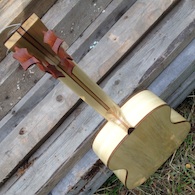Welcome to one of the most active flamenco sites on the Internet. Guests can read most posts but if you want to participate click here to register.
This site is dedicated to the memory of Paco de Lucía, Ron Mitchell, Guy Williams, Linda Elvira, Philip John Lee, Craig Eros, Ben Woods, David Serva and Tom Blackshear who went ahead of us.
We receive 12,200 visitors a month from 200 countries and 1.7 million page impressions a year. To advertise on this site please contact us.
|

|
|
Changing strings
|
You are logged in as Guest
|
|
Users viewing this topic: none
|
|
Login  | |
|

   
kitarist
Posts: 1715
Joined: Dec. 4 2012

|
 RE: Changing strings (in reply to johnnefastis) RE: Changing strings (in reply to johnnefastis)
|
|
|
quote:
ORIGINAL: johnnefastis
That doesn't make sense though. Don't you end up with loads of winds on the tuner then?
No, what you do is, after you pass the loosely-wound (aka 'flexible') end through the tuner hole, you take up any string slack before you do the looping and tying. At that moment you have a secured fairly taut string, and some amount of string including the loosely-wound portion is free and flops around, but does not participate (it is not wound on the tuner) in the subsequent turning the tuner to tune to pitch as you've kind of locked that part out of that process (you can cut off that part later).
Now you need not just less turns to get the string to pitch, but also less adjustment time for it to get to stable pitch because the string wound on the tuner itself is a much smaller amount (that part also stretches some and has to get to equilibrium, so the less of it is there wound on the tuner the better). For that reason I do exactly the same (pull the string taut before tuning) for the trebles, which are much more stretchable.
I also went through experimenting with whether the loosely-wound end goes on the tuner side or the bridge side. I believe some teachers may have come up with the "loose wound end goes on the bridge" advice in order to avoid it being wound around the tuner and possibly falling apart there while trying to tune - however, the idea here is that you pull the string taut BEFORE you start tuning up, so that whole section wound not be part of any subsequent tuning.
Putting it on the bridge side is not particularly good advice UNLESS you add that none of that loosely-wound part should be tied on the bridge - it should be just a free end flopping around (and cut off later). But then I personally get worried I will not have enough length to tie the string on the other side, so really it is much better to "exclude" the loosely-wound end at the tuner side rather than at the bridge side.
I believe many people, in trying to follow the advice without the clarification, try to use that loose/flexible portion as part of their bridge tie, and this is not good as that part can easily fall apart and can take part of the strands inside with it. Then you try cutting the unravelling part off and if you are not careful may unravel it a bit more, and it gets hairy 
For all these reasons, what Morante described is exactly right - the best way to tie a string is to "exclude" the loosely-wound end on the tuner side; pull the string taut before tuning so fewer tuning loops are needed.
BTW, if you find that the firm end is too straight and can't easily bend to pass through the bridge hole (passing the easily-bendable loosely-wound end is sometimes another reason given for why put that end on the bridge side), just bend the end a bit around some hard cylindrical object - I do it around the handle part of my plastic string winder. You just need the smallest bend of the firm end; a few degrees.
Lastly, what to do with the loose string sections (which include the loosely-wound section of the bass strings) hanging from the tuners? You can leave them on like a rock'n'roller, or cut them off. I found that if I leave them on, I sometimes get weird buzzing, and it turned out it was from these bits interacting with the head and tuning machines. Cutting them off removed that buzz. Same with the smaller bits left on the bridge side - I cut them off as they can rattle as well if left on (also looks neater but that's secondary).
_____________________________
Konstantin
|
|
|
|
REPORT THIS POST AS INAPPROPRIATE |
Date Feb. 20 2021 18:25:00
 |
|

  
ernandez R
Posts: 737
Joined: Mar. 25 2019
From: Alaska USA

|
 RE: Changing strings (in reply to Morante) RE: Changing strings (in reply to Morante)
|
|
|
Ah, skinning cats, everyone has the best way...
I do the trebles first, I pull one through the tie block and then melt a ball with a lighter, one at a time and bring them up taught but nothing near tension. This allows the nylon to take a set around all the corners of the tie block and string hole in the peg, then I do up the wound strings one at a time and these I bring up about 50¢ sharp. If I’m happy with the bases I cut them about 1/8” sticking out the peg with a good cutting pair of nail clippers. I usually end up with 1.5-2 wraps around the E, 3ish around the A and 4 around the D peg. About the same with the G, B, and e accordingly.
Once I’m done with the wound strings I’ll go back to the trebles and bring them up to tension. Depending on my mood I’ll trim them at the peg with a 3/16” pig tail, unwind, carefully melt a ball, then rewind to tension. Or just clip.
I like to keep the string close to the peg stock veneer cause I feel it makes the peg a little more user friendly but not sure it’s all that important?
I blow through the D string in about five days, lately I’ve been strapping on the cagilla (sp ?) and playing fret two, three, or five for a few days.
When I order strings I’ll get three full sets, three bass sets, and three D strings. I work them accordingly and reorder the whole set once I’ve wiped the windings off then all. I’ve been playing 2-4 hours a day thanx to this bumb foot and the Covid but I’m not complaining.
Have wondered if the fat frets I build with have something to do with the string wear? Poor left hand technique?
HR
_____________________________
I prefer my flamenco guitar spicy,
doesn't have to be fast,
should have some meat on the bones,
can be raw or well done,
as long as it doesn't sound like it's turning green on an elevator floor.
www.instagram.com/threeriversguitars
|
|
|
|
REPORT THIS POST AS INAPPROPRIATE |
Date Feb. 20 2021 22:57:34
 |
|
 New Messages New Messages |
 No New Messages No New Messages |
 Hot Topic w/ New Messages Hot Topic w/ New Messages |
 Hot Topic w/o New Messages Hot Topic w/o New Messages |
 Locked w/ New Messages Locked w/ New Messages |
 Locked w/o New Messages Locked w/o New Messages |
|
 Post New Thread
Post New Thread
 Reply to Message
Reply to Message
 Post New Poll
Post New Poll
 Submit Vote
Submit Vote
 Delete My Own Post
Delete My Own Post
 Delete My Own Thread
Delete My Own Thread
 Rate Posts
Rate Posts
|
|
|
Forum Software powered by ASP Playground Advanced Edition 2.0.5
Copyright © 2000 - 2003 ASPPlayground.NET |
0.078125 secs.
|


 Printable Version
Printable Version





 Not at the bridge?
Not at the bridge? 













 New Messages
New Messages No New Messages
No New Messages Hot Topic w/ New Messages
Hot Topic w/ New Messages Hot Topic w/o New Messages
Hot Topic w/o New Messages Locked w/ New Messages
Locked w/ New Messages Locked w/o New Messages
Locked w/o New Messages Post New Thread
Post New Thread